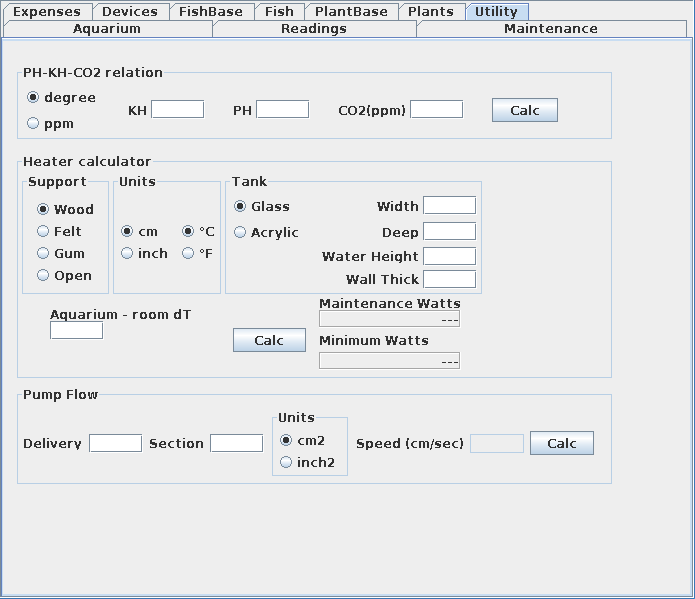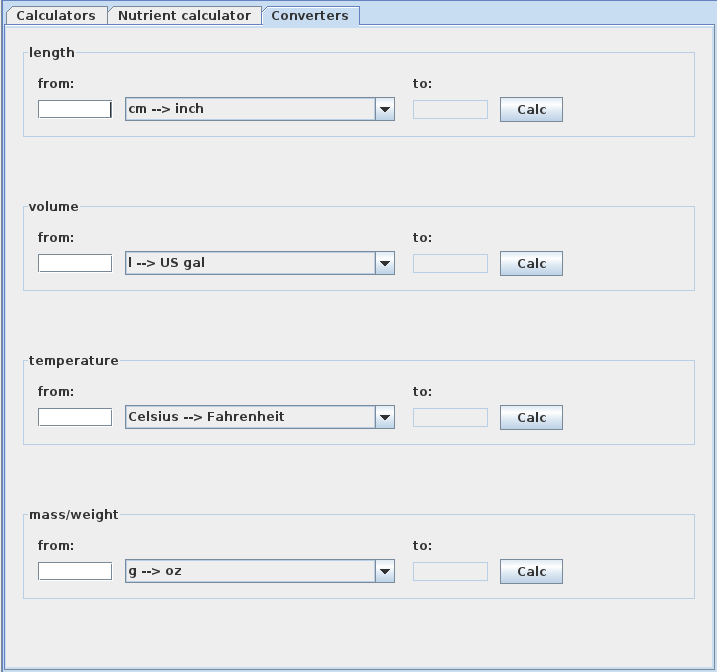

Staring from version 3.0 utilities has been arranged in a different tab and some new features has been added.

This calculator is based on the following formula:
pH=7,5+Log(KH)-Log(ppmCO2)
Any of KH, PH or CO2 terms can be derived from the other two. KH can be expressed in ppm or degree (selecting the correct radio button). The CO2 is ever in ppm (parts per milion).
Insert two values and press [Calc] button to get the third.
This calculator give You the minimum (and maintenance) Watt required for heater to keep the delta of temperature between aquarium water temp and room temp.
In Support You should select the type of material of the support that is under Your aquarium
In Units select the units for temperature (°C or °F) and for length
In Tank select the material of tank glasses. Insert the width and deep of the tank and the water level height (to calculate water volume). Insert the wall (glass) thick.
Insert the delta between room temperature and water desired temperature and press [Calc] button.
This calculator uses following formulas:
* fahrenheit to celsius (delta T) 1 °C = 1°F 5/9
* kelvin to celsius T(°C) = T(K) - 273,15
* inch to cm cm = in * 2.54
* Joule to cal J = cal x 0.23889 (1J=1W/sec)
* one dimensional heat conduction; Q= k AdT/s
where:
units:in 1 W m−1 K−1 = 418.7 x cal cm cm−2 s−1 C−1
k=material thermal conductivity
A=area (surface) of material
s=thick (section) of material
dT= delta of temperature
Note: The area is given from the external surface of water (all surfaces of the tank + bottom) and the material that is used as insulator from air (the glass or the bottom). Obviously the glass and the bottom support has different termic coefficients.
Thermal Conductivity materials coefficients (at 20°C) in cal cm cm−2 s−1 C−1
Glass= 0.0025;
Acrylic=0.0004;
Felt=0.00009;
Wood=0.0002;
Gum=0.00005;
Open=0.025;
Useful to calc water speed at pump output. This value is affected from some approximations because it's hard to say which is the smallest section in whole system.
Required parameters:
Delivery: It's impossible to determinate the real value so you can use the nominal one. Take care to reduce this value if the pump has any control valve.
Section: The smallest one in water path.
You' ll get max speed of water for these conditions.
Used formula is:
Q=A*V*Cos(ϴ) => V=Q/A*Cos(ϴ)
Where:
* Q= pump delivery in liters/h
* A= minimum section of path trough pump or pipes
* V= speed of the flow
* for radial flow Cos(ϴ)=1 =>
* V=Q/A cm2/Sec
* 1 cm=2.54 inch 1cm2= 2.54*2.54 inch2
* V=Q/(A*6.4516) inch2/sec
This form is used to do some different calculations on fertilization, in a single form different calculators are managed. Some therms need to be defined to understand how it works.

An important WARNING: a wrong fertilizers' dose may lead to death fish, invertebrates and plants. We can't ensure that all results are right, so, you are strongly encouraged to check results with other tools. Please report to us any wrong result or bug so we can improve this tool reliability.
The tool can do the following calculations:

Dose to reach target: How much fertilizer you need to add to tank to reach the target value (in ppm *) of a specific element
The result of a dose: How much of each element of the compound will be added to tank with a given dose.
Estimative Index: The same as (1) but the target is the value expected from E.I. Protocol (see: http://www.barrreport.com/showthread.php/62-The-Estimative-Index-of-Dosing-or-No-Need-for-Test-Kits)
Estimative Index Daily: The same as (3) but for daily dosing
Estimative Index Weekly: The same as (3) but for weekly dosing
Perpetual Preservation System: The same as (1) but the target is the value expected from P.P.S. Protocol (see: http://www.aquaticplantcentral.com/forumapc/fertilizing/4241-pps-perpetual-preservation-systems-aquatic-plant.html)
Poor Man Dosing Drops: The same as 1) but the target is the value expected from P.M.D.D. Protocol (see: http://www.thekrib.com/Plants/Fertilizer/sears-conlin.html)
The button with number 0 performs cleaning of the fields
The one indicated with the number 8 creates the report.
The calculations may operate over products that can be powder or solutions of basic elements or compounds. You can use them as pure powder or solution (as-is) or add water or mix other elements to obtain your own diy solution.
So what is involved in operation is:
The tank water volume: this is the net volume of water contained in the aquarium (filter volume should be excluded). You can chose in Units if value is in liters or US gallon.
The initial solution/product. Choosing the type of the compound a graph is shown that represents the chemical elements that compose it, and in what is the relative percentage.
You must chose if you are dosing a solution or powder. In fact it may happen that the amount of the powdered compound, to be dosed into the aquarium, is too small to be measured (usually the case) and it may be more convenient to prepare a solution of water and compound. If you chose solution 2 extra values are required:
The solution water volume: This is the amount of water (in ml) used to solute the compound
Dose volume: The dose of solution (in ml) that you will add to tank. It should be a comfortable dose not to little that you cant measure it, not so big that you can't use.
At this point you should chose the method alias the operation (1 to 7 of previous list) you want to calculate. Depending on method following informations may or not be required.
The target element - that is the primary element you add to the water of aquarium when you add the compound (secondary elements qty are also showed in the Elements Added table). For method (1) you should add the value in ppm (see *) you want to add. In method 3 to 7 this value is dependent from method and is showed after calculation. In method (2) this value is not required.
When you use method (2) you are requiring to calculate the result of your dose so there is an extra field (Adding) where you should indicate this value and chose the unit (mg/ml or g). In all other calculations no more data are required so you can press Calc button.
The results:
For method (2) the values on the Elements Added table are the amounts of each element you are adding in aquarium with that dose.
For other methods the Result field show the value of compound or solution you should add in aquarium to reach the target that you choose or the target that is defined by the method you choose.
An appropriate icon indicates whether the solution is soluble in water or less. In case of indication of insolubility you must increase the dilution or reduce the dose (depending on the case).
The graph showed in the bottom compares the primary element values required in variious methods.
Specific alerts (depending from primary element) can also appear to show if toxicity thresholds are exceeded or if the compound has any contraindications.
New:
Since version 5.0.0 you can save your most frequently used calculations and results in a list called "recipes."
To save a recipe enter a name in the dropdown box in the top left corner and press the save button.
![]()
To review a recipe simply select from the list.
You can delete recipes saved by selecting them and using the right button.
* ppm:
In science and engineering, the parts-per notation is a set of pseudo units to describe small values of miscellaneous dimensionless quantities, e.g. mole fraction or mass fraction. Since these fractions are quantity-per-quantity measures, they are pure numbers with no associated units of measurement. Commonly used is ppm (parts-per-million, 10–6). In case of water solutions being 1l of pure water = 1kg it follows that 1ppm=1mg/l.
Some extra information on Calculations:
To calculate the result the used formula is: x=targ * (1 / k) * AV * (SV/DV)
Where:
x= solute in mg/l = amount of powder (or liquid) to put in water to get the solution
targ = target quantity in ppm or mg/l for the element to reach in tank
K= value of target lement contained in a unit of the initial compount
AV= Aquarium Water total volume in liters
SV= Solution Water volume in ml
DV= Dose Volume (the minimal dose used to reach targ in ml
for each element the formula is: targ = x * K * {1 / [AV * (SV/DV)]}
where:
x= solute in mg/l = amount of powder (or liquid) to put in water to get the solution
targ = target quantity in ppm or mg/l for the element to reach in tank
K= value of target lement contained in a unit of the initial compount
AV= Aquarium Water total volume in liters
SV= Solution Water volume in ml
DV= Dose Volume (the minimal dose used to reach targ in ml
This utility provides conversion operations for the main unit of length, volume, temperature and mass / weight.

Operation is simple: enter the value to be converted in from field. Choose from the drop-down box a conversion operation and click on the Calculate button. The field to will show the converted value.